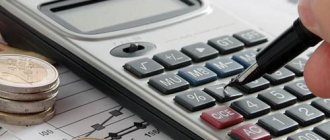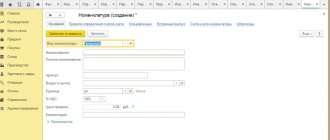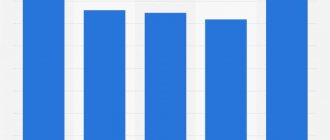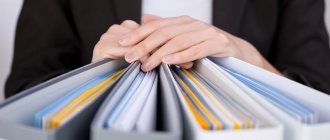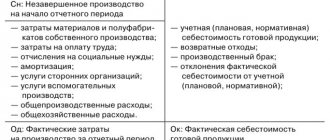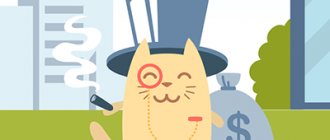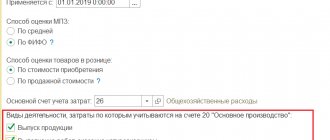The production process is a reflection of the transformation of raw materials and materials into a finished product. This is one of the most important elements of accounting in an enterprise, since it reflects costs and expenses for raw materials in comparison with the profit from products sold. The correctness of this accounting ensures timely tracking of the organization’s financial results and allows for effective management.
Question: How are the receipt of materials, the costs of their delivery, as well as the write-off of these materials into production reflected in accounting, if in accounting the materials are reflected at accounting (planned) prices using accounts 15 “Procurement and acquisition of material assets” and 16 “ Deviation in the cost of material assets”, while the actual cost of purchased materials exceeds their book price? View answer
Let's consider what are the features of accounting for the production process at an enterprise.
Production and cost
Production is the main goal of creating any enterprise. Employees, using the necessary tools, during various business operations transform raw materials into goods ready for sale - this is the production process . It also includes activities aimed at performing work and providing services. Products appear during the merger:
- labor resources;
- objects of labor;
- costs of "manpower".
In order to correctly determine the unit cost of each type of product and the entire array as a whole, you need to take into account all the costs invested in its production. Some of the costs will be included in the cost price, some will have to be left “outside the brackets” - accounting will show which ones.
the distribution of administrative (general) expenses in the accounting of a production organization ?
Industrial Accounting Principles
In principle, both the organization of accounting for agricultural production and the solution of related problems in a software company will be carried out with an emphasis on:
— to ensure the comparability of information related to the accounting category with planned indicators;
- for the effective distribution of functions for collecting the necessary accounting information, as well as generating accounting documentation - between competent specialists of the company;
— to use advanced, technological approaches to the implementation of accounting;
- on the unity of the documentary base used by various divisions of the company in the formation of information, and documents that are related to accounting.
What is reflected in production accounting
To record the dynamics of the production process, the accountant should take into account:
- expenses arising in the process of manufacturing the finished product;
- funds spent on finished products and on those goods whose production has not yet been completed;
- the sum of all resources for creating products;
- fluctuations in cost, factors of its growth and reduction possibilities.
How to reflect in the accounting of a contracting organization the production of excisable products on a toll basis and their transfer to the customer?
Forms of production costs
Production costs are those costs incurred by an enterprise during the transformation of raw materials into products. All manifestations of these costs are taken into account:
- material;
- financial;
- resource.
Question: How to reflect in the accounting and financial statements of an organization (LLC) the correction of a significant error made in 2019, which was identified in December 2021? In November 2021, the organization produced products and sold them in the same month. The actual cost of raw materials used in production in accounting (amounts to 600,000 rubles, equal to the cost of its acquisition in tax accounting), due to the fault of the organization's accountant, was erroneously not written off as production costs and cost of sales, and was also not taken into account for profit tax purposes. View answer
In fact, these costs represent one or both options for the movement of monetary (sometimes non-monetary) funds:
- payment to third parties;
- increase in obligations to counterparties.
Classification of production costs
The division of costs is due to a different approach to their accounting:
- Fixed (overhead) and variable costs - characterize the relationship of costs to the production process. The first ones are related to the organization of the production process; they do not change, even if the volume of goods grows. The second group ensures the production process itself - the purchase of raw materials and payment of labor, so this part of the costs is subject to dynamics.
- Direct and indirect costs are associated with the attribution of expenses to cost. The former are included directly in it, reflecting the connection with the production of each individual unit (for example, the cost of materials). The latter are distributed across several types of products at once; they must be included in the cost within the framework of the methodology adopted by the enterprise.
What is included in production costs
We list the main items of the enterprise’s expenses for creating products, which must be reflected in accounting:
- wages for personnel – workers, maintenance, management;
- the cost of objects of labor that were spent on production and household needs;
- depreciation of equipment, as well as premises, household equipment, etc.
NOTE! In these expenses, part is included in the cost directly (direct costs), and part is distributed indirectly.
Main sources of data for accounting
In any industry, be it electronics or furniture manufacturing, accounting is maintained using similar types of sources. They will be classified on the following basis:
- compound;
- purpose;
— duration of formation;
— level of generalization.
Based on their composition, accounting documents are divided into:
— incoming — those that come to the organization from third-party business entities;
- outgoing - which are transferred from the company to other organizations;
- internal - their turnover is carried out within the enterprise.
According to their purpose, accounting documents are classified:
- administrative - those that reflect management decisions regarding certain business transactions;
- executive - those that legally secure the relevant operations.
Of course, in the document flow of an enterprise, documents that are difficult to unambiguously be classified as administrative or executive can also be used. For example, these can be certificates, various calculations and registers, through which, for example, a competent specialist can reflect production costs in accounting.
Based on the duration of their formation, accounting documents are divided into:
- one-time - those that reflect a single business transaction;
- cumulative - those that are formed during a particular period in order to reflect information about the same type of business transactions.
Based on the degree of generalization, accounting documents can be divided into:
- to primary ones - those that reflect the operation immediately at the time of its implementation (for example, when shipping materials);
— consolidated ones, which include data on several primary documents.
Using the above documents, almost any business transaction can be recorded at an enterprise. In principle, they are suitable not only for such a segment as the production sector. Accounting using the listed sources can be carried out by a trade or service enterprise.
Of course, the practical application of certain documents may be determined by the peculiarities of business operations in a particular company. But the classification of sources will remain unchanged, as well as the basic principles of handling them, since accounting procedures are quite strictly regulated.
Let us now consider the main tasks of accounting at industrial enterprises.
Accounts for accounting of production process
To maintain production records, an accountant will need several separate accounts:
- Account 20 “Main production”. During the reporting period, it accumulates the costs of manufacturing products included in the cost price, namely:
- cost of materials, raw materials;
- remuneration for the labor of workers participating in production;
- payments to various social funds;
- resource costs (water, electricity, etc.).
- Account 23 “Auxiliary production” collects the costs of those production structures that are not directly involved in the production of products, but provide and maintain the functioning of the main purpose. For example, these are the costs of maintaining your own boiler house, power plant, water pumping facilities, etc.
- Account 25 “General production expenses” associated with the use of equipment, machines and mechanisms. It reflects:
- funds for fuel and lubricants;
- depreciation of mechanisms, buildings, structures;
- maintenance costs;
- salaries for repairmen and adjusters;
- equipment testing;
- other similar costs.
- Account 26 “General business expenses” records the areas of expenses that are designed to support the work of the entire enterprise, including management functions and implementation. These include the following types of costs:
- salaries and other payments to management employees;
- business trips;
- funds for equipping and repairing office premises;
- payment for stationery;
- communication and Internet services, etc.
- Account 28 “Manufacturing defects” is the “saddest” of the expense accounts, but, unfortunately, necessary. The cost of all substandard products, if subject to write-off, will be reflected in the debit of this account. If it is nevertheless sold, albeit at a discount, these funds will be used against the loan.
- Account 29 “Servicing industries and farms” shows the share of costs for maintaining activities not directly related to production:
- expenses for operating subsidiary workshops (sewing, repair, etc.);
- payment for internal canteens, buffets;
- costs for auxiliary facilities (baths, laundries, dormitories, etc.);
- departmental kindergartens, sanatoriums.
- Account 96 “Reserves for future expenses” accumulates expenses for the coming periods, including:
- vacation pay for workers;
- long-service benefits for production personnel;
- funds for repairs;
- money for preparatory measures to launch a new line or change seasonal production.
- Account 97 “Future expenses” – used when costs have already been incurred, but will have to be taken into account later. In the production process it reflects:
- exploration costs;
- prepayment for advertising, etc.;
- funds for the expansion of technological lines, new equipment, product range, etc.;
- licensing, certification.
Postings for accounting for production costs
The full cost of finished products includes production costs and sales costs. How production and sales costs are accounted for in accounting, what accounts are used and what postings are made.
Accounting accounts for production costs
There are several accounting accounts for recording production costs. In the chart of accounts, Section 2 is devoted to the production process, which provides a list of accounts involved in this process.
Main production (count 20)
Direct costs of main production are collected in the debit of the account. 20.
Account 20 “Main production” is intended to take into account the direct costs of the main production and form the actual cost of production.
The direct costs are:
- Raw materials - posting Debit 20 Credit 10
- Semi-finished products of own production - posting Debit 20 Credit 21
- Depreciation of fixed assets - posting Debit 20 Credit 02
- Amortization of intangible assets - posting Debit 20 Credit05
- Staff salaries – posting Debit 20 Credit 70
- Insurance premiums from staff salaries - posting Debit 20 Credit 69
- Services of third parties – posting Debit 20 Credit 60
Postings for cost accounting of main production:
| the name of the operation | ||
| 20 | 02 | Depreciation was calculated on fixed assets used in the main production |
| 20 | 05 | Depreciation was accrued on intangible assets used in the main production |
| 20 | 70 | Wages accrued to employees of main production |
| 20 | 69 | Insurance deductions are calculated from the salaries of production workers |
| 20 | 10 | Raw materials and supplies released into production are taken into account |
| 20 | 21 | The cost of own semi-finished products was written off to the main production |
| 20 | 60 | The cost of third-party services for main production is taken into account |
Ancillary proceedings (account 23)
Account 23 “Auxiliary production” is intended to account for the direct costs of auxiliary production, which include the repair of fixed assets involved in the production process, transport services, and power supply.
The postings for accounting for these costs look similar, only instead of invoice. 20 is taken count. 23.
General production expenses (account 25)
This account is intended to collect costs associated with the maintenance of main and auxiliary production. These are indirect costs that are collected in the debit of the account during the month. 25
The same costs include depreciation, staff salaries and deductions from them, materials, etc. The postings for accounting for general production expenses look the same as for the main production, only instead of invoices. 20 is taken count. 25.
General expenses (account 26)
The debit of this account collects expenses for administrative and managerial needs, these are also indirect expenses that are collected throughout the entire month in the debit of the account. 26.
Defects in production (count 28)
Another type of cost that must be taken into account in the production process is losses from defects.
If defective products are produced during the production process, then eliminating them will require certain costs, which include depreciation, materials, raw materials, semi-finished products, wages and deductions from them. Accounting for the costs of correcting defects occurs on account 28 “Defects in production”, in the debit of the account. 28, all these costs are collected using the postings indicated above (instead of account 20, account 28 is taken).
Thus, at the end of the month, according to the debit of the account. 20 collected direct costs associated with basic production in the debit of the account. 23 – direct costs associated with auxiliary production, in the debit of the account. 25 – indirect overhead costs, in the debit of the account. 26 – indirect general business expenses, in the debit of the account. 28 – costs associated with defective products.
The next step in the formation of production costs is the distribution of auxiliary production costs between main production, general production and general economic needs.
Postings for distribution of costs of auxiliary production:
| Debit | Credit | the name of the operation |
| 20 | 23 | The cost of auxiliary production allocated to the main production was written off |
| 25 | 23 | The cost of auxiliary production allocated for general production needs was written off |
| 26 | 23 | The cost of auxiliary production allocated for general business needs has been written off |
The next step in the formation of product costs is the write-off of general production and general business expenses.
Postings for writing off these costs are D20 K25 and D20 K26.
General production costs can be written off proportionally:
- Salaries of main production personnel
- Wasted materials
- Amount of direct costs
- Revenue from the sale of manufactured products
General business expenses are written off:
- By distribution between types of products
- In full at the end of the month
The last step is to write off losses from marriage.
Accumulated by debit account. 28, the costs of correcting defective products are written off to the debit of account 20 by posting D20 K28.
As a result of the manipulations performed on the debit of the account. 20 the production cost of products is formed.
The next stage is the formation of the cost per unit of production using calculation.
Principles of production cost accounting
- When reflecting cost data in accounting, you need to correlate their actual indicator with the planned one.
- When documenting costs that coincide with the planned ones and those incurred with deviations, they are reflected separately.
- The cost includes all costs of producing goods in the accounting period.
- Various accounting accounts combine expenses for certain objects and cost items.
- Cost accounting objects must clearly coincide with the calculation objects to correctly reflect the cost.
Main requirements for industrial accounting
Accounting in production is a type of activity of competent specialists, the results of which may be subject to a number of serious requirements. Thus, the information recorded in accounting should be:
— objective;
— timely;
— operational;
- verifiable.
Another significant criterion here is the suitability of accounting information for reading, if necessary, by a person who is not an accounting specialist. This could be, for example, an investor or shareholder who has a general understanding of accounting, but at the same time expresses an interest in getting acquainted with information reflecting the state of affairs in the business.
Financial result of the production process
If you reduce the revenue received from the sale of goods by cost, the result will be a gross profit, which clearly reflects the efficiency of the enterprise.
Account 90 “Sales” reflects this result: if the credit is greater than the debit, we have a profit, the debit exceeds the credit, there are losses. The balance is displayed as follows:
- Reflection on the loan of the amount of proceeds from the sale of goods (with or without VAT - what methodology is adopted in the organization). This will require wiring:
- debit 62, credit 90.3 – cost accounting without VAT;
- debit 90.3, credit 68 – with value added tax.
- Calculating the cost of goods and writing it off from the appropriate accounts. Postings:
- debit 90.2, credit 20;
- debit 90.2, credit 23.
- The conclusion of the resulting balance on account 90 and 91 to account 99 “Profits and losses” is the final entry of the year, which will be reflected in the annual balance sheet.
IMPORTANT! If account 99 has a loan balance, it means the result is positive and the company has retained earnings at its disposal. When there is a debit balance, it is necessary to review the production and sales management policy.
Thus, accounting data becomes the basis for making vital decisions for the enterprise.
Industrial accounting: main tasks
Again, regardless of the specific segment, be it aluminum production or furniture production, accounting at industrial enterprises is carried out in order to solve the following problems:
— formation of reliable information about the economic processes in the company, as well as the results of its economic development for a certain period;
- control over the movement of various assets and liabilities that belong to the organization, labor, financial resources - based on the operation of established rules of law;
— development of local standards;
— increasing production efficiency through analysis of key indicators recorded in accounting.
These tasks must be solved taking into account the provisions of regulatory legislation on accounting, various by-laws, clarifications of departments, and provisions of internal corporate regulations.
There are also a number of industrial accounting principles.
How to maintain a balance sheet for an enterprise.
Assets are all the property of an enterprise that it can dispose of for its activities and make a profit from it (Table 1).
Table 1
| Enterprise assets | |
| I. Non-current assets | These are assets that are on the balance sheet and have been used for more than 1 year |
| Intangible assets (IMA) | business reputation, know-how, patents, licenses |
| Fixed Assets (Fixed Assets) | land, buildings, structures, machinery and equipment, etc. |
| Capital investments | investments in material assets that generate income |
| Long-term financial investments | long-term loans and investments issued |
| II. Current assets | These are those assets that are in constant circulation, their useful life is no more than 1 year |
| Inventory and costs | raw materials, materials, goods |
| VAT on purchases | value added tax |
| Finished products | |
| Accounts receivable | debts of other persons to your company |
| Short-term financial investments | short-term loans to companies |
| Cash | cash and non-cash, in domestic and foreign currencies |
Liabilities are a set of sources for the formation of enterprise funds (Table 2).
table 2
| Liabilities of the enterprise | |
| III. Capital and reserves | This is the property of the company |
| Authorized capital | the amount of money invested by the owners to make the business work |
| Extra capital | receipts aimed at replenishing current assets or equity capital of the enterprise |
| Reserve capital | part of the enterprise’s property used to place retained earnings in this section, to cover losses, etc. |
| retained earnings | accounting account of retained earnings that a company received as a result of all its activities in the reporting period |
| IV. long term duties | This is the debt of an enterprise on long-term loans (over 1 year) to banks and other organizations from which the loan was taken |
| Loans | |
| Loans | |
| V. Current liabilities | This is debt on short-term loans (less than 1 year) to banks and other organizations providing loans |
| Credits and loans | |
| Accounts payable | |
Stages of production in 1C 8
The production process of creating any product is divided into several conditional cycles:
- purchasing materials;
- their transfer to production;
- release of finished products;
- calculation of the cost of manufactured goods.
Let's take a closer look at how 1C takes into account production as a process and how its stages are reflected. We will use the most popular and widespread program as a tool. allowing you to automate production accounting - “1C: Enterprise Accounting 3.0”. An example would be the production of leather goods.
Accounting for semi-finished products of own production in 1C
The use of the mentioned account 21 is necessary for organizations in which the production of semi-finished products is one of the production cycles. For all other enterprises, accounting for semi-finished products is carried out as part of WIP accounting. In correspondence on the debit “Main production” of account 20, it is necessary to reflect the amounts of actual costs incurred in the manufacture of semi-finished products. According to the loan, the cost of used semi-finished products is written off to the same production accounts.
As with the release of finished products, the production of semi-finished products is noted in the report produced per shift in the “Product Release” menu. To do this, fill in the following fields one by one:
- write-off account (“Main production” 20/1);
- the production unit that produced the semi-finished product;
- planned cost;
- “Semi-finished products of own production” accounting account 21.
Carrying out this document is necessary to account for the semi-finished products available in the warehouse.
Accounting nuances: production organization
The organization of production can be built on different principles. The most popular approaches here include threaded and non-threaded. The organization of production of the first type involves building special technological lines at the factory, using which the sequential assembly of the finished product is carried out.
Accounting for the costs of production and circulation in a flow scheme, as a rule, is easier to organize based on the strict regulation of the operations of the production of goods by the enterprise. In turn, in non-line production, equipment is installed on a group basis. Specialists working in each of the relevant departments perform part of the specified operations, after which they transfer the semi-finished product or a certain part of the product for assembly to another department of the company.
Requirements for accounting information
In relation to accounting information, a number of requirements can also be identified. They will be relevant regardless of the specific stages of production of goods (delivery of finished goods - although separate accounting is maintained for them, production of semi-finished products). We are talking about the following requirements:
— compliance with the accounting policies adopted by the company;
— complete and reliable reflection within the accounting period of indicators on the property and business operations of the company;
— ensuring the identity of analytical and synthetic accounting indicators;
- effective distribution of production costs - for example, into current and capital, classification of income and expenses for specific periods.
Does a specific area of economic activity matter from the point of view of setting priorities in the organization of accounting? As a rule, there is a dependence here. Let's study its specifics.
Accounting for the release of finished products in 1C
In accordance with the results of the shift, a corresponding document is created in the “Production” menu. It should reflect the results expressed in the number of units of products (bags) sewn in one shift.
To enter data, you will need to click the “Create” button, after which a specific product is selected in the “Nomenclature” directory - black leather bags, the number of units produced per shift and the planned estimated cost of the products are established (actual cost results are calculated at the end of the month after all regulatory operations have been completed).
You should pay attention to that. that a production report for each shift can also be generated based on the data entered in the “Requirements-invoice”.
Important! In the specified document, you will need to select “Finished products” - account 43, and link the specification related to specific bags, because other products, despite the same costs for their production, may be of a different color.
Clicking the “Fill” button in the “Materials” tab allows 1C to automatically transfer all necessary materials from the specification to the production of one unit of product. At the same time, quantitative characteristics can be edited. At the same time, the materials necessary for production are written off: threads, leather, fittings, lining material.
When carrying out the operation, a posting occurs: Debit “Main production” 20 account / Credit “Materials” 10 account.
This operation is simultaneously accompanied by a posting for the release of finished products from production: Debit “Finished Products” of account 43/Credit “Main Production” of account 20.
